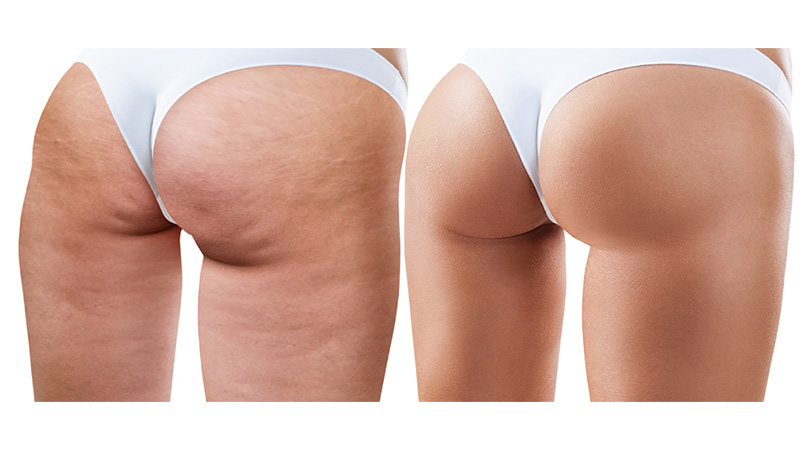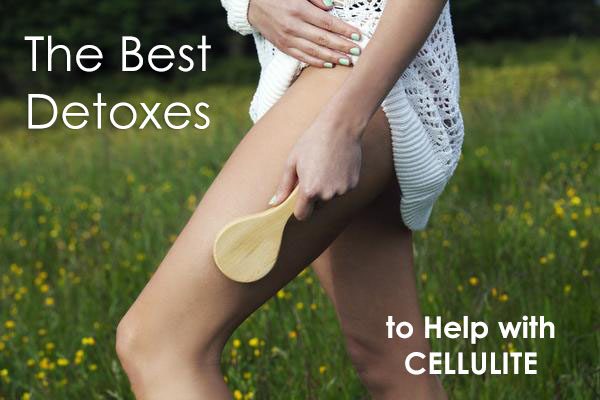Here’s What You Need to Know About Cellulite & How to Handle It
For many people, cellulite is a big issue. According to Scientific American, cellulite is a condition that affects 90% of women and 10% of men. While many people understand what cellulite is, rarely do they understand where it comes from, how it gets there, and how they can accurately and effectively address their personal cellulite problems. Read on to learn more about the complexities of cellulite and how you can handle it:

What is Cellulite & How Do You Get It?
Cellulite occurs when estrogen starts decreasing in the body. As estrogen decreases, receptors in blood vessels are lost, which results in decreased circulation. And when circulation decreases, certain areas of the body with multiple layers of fat, like the butt and thighs, get less oxygen and nutrients—thereby decreasing collagen production. As fatty cells get larger, they protrude through collagen, which creates the appearance of cellulite. Typically, women start seeing the appearance of cellulite between the ages of 25 to 35, though it’s possible to happen much sooner or later.
Cellulite Myths
There are common misconceptions about cellulite that you should keep in mind. For starters, cellulite isn’t present in only heavier women; skinny, smaller women are prone to cellulite, too. Even young, thin teenagers aren’t exempt. Furthermore, there’s another myth that women who exercise will miraculously lose their cellulite. This isn’t the case. While you should certainly exercise to reduce excess fat on the body, it’s important to know that certain exercises can actually worse cellulite.
“Most experts agree that the best way to reduce and eliminate the [bulging] of subcutaneous fat within connective tissue is aerobic exercise and weight training,” Shane Allen, a certified weight loss specialist, told Huffington Post. “Strengthening the fibrous connective tissue under the skin helps regain elasticity, which makes the appearance of cellulite less prevalent.”
And finally, many people falsely assume that a sun tan will rid them of cellulite when the truth is, it will only mask the appearance of it—and can also exacerbate the problem. The sun’s UV rays can further damage your skin by breaking down the elastin and collagen network in your skin.
The Cellulite Link to Confidence
Today, we live in a pop culture-fueled society that makes women feel bad about their cellulite, despite the fact that it’s perfectly natural. Cultural beauty standards have perpetuated the myth that cellulite is an abnormal condition. Studies have shown that when you are happy about the way you look, you benefit with a boost in confidence. People who aren’t happy with the way they look struggle to make progression in their personal and professional lives. This doesn’t just have to do with cellulite either; some people aren’t happy with their teeth, and others aren’t happy with their weight or hair. Each of these things impacts the way they perceive themselves and the way they believe others perceive them.
Getting Rid of Cellulite
It’s clear there is a distinct link to an individual’s self-esteem and their physical appearance. As a result, a barrage of products have merged promising to reduce or eliminate cellulite altogether. The issue with many of the products you see on the market is that they only address fat decrease, rather than circulation, which, as previously mentioned, plays a major role in the development of cellulite.
Endermologie cellulite treatment is one of the first natural/non-invasive treatments to effectively treat cellulite, though it depends on the amount of cellulite that you have, as some cases of cellulite are more difficult and may require more Endermologie sessions. During an Endermologie procedure, the skin is massaged and rolled to increase circulation and actually help smooth the skin and reduce the appearance of cellulite.
Keeping Cellulite Away With Lifestyle Changes
Even with medical treatments like Endermologie and other fat-reducing creams, your efforts will prove futile if you don’t adjust your lifestyle, too. There’s a reason why women in more undeveloped countries very rarely have cellulite; they are moving constantly and their diets don’t consist of fast food. In industrialized, developed countries, the majority of people live sedentary lifestyles, where we’re sitting at desks for the majority of the day and don’t exercise to balance our bodies, which weren’t made to be in resting positions for such a large portion of our lives. Therefore, it’s important that you eat healthy and partake in healthy exercise and activities.

